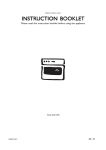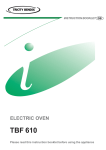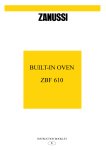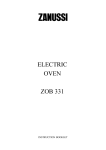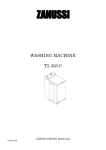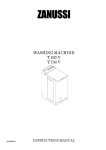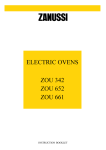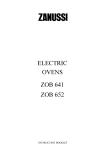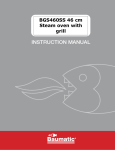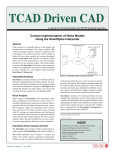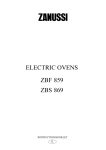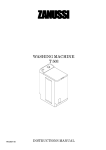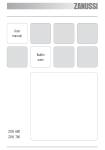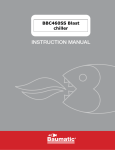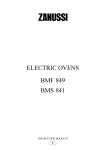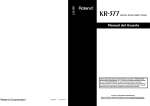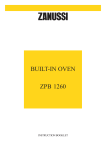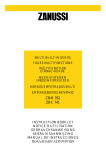Download Zanussi ZBS 862 User's Manual
Transcript
EINBAU-BACKOFEN MIT
DAMPFGARENRICHTUNG
FOUR À VAPEUR
STOOMOVEN
BUILT-IN STEAM OVEN
ZBS 862
GEBRAUCHSANLEITUNG
NOTICE D'UTILISATION
GEBRUIKSAANWIJZING
INSTRUCTION BOOKLET
ENGLISH
☛Warning
These warnings are provided in the interest of safety. You
installing or using the appliance.
MUST
read them carefully before
It is most important that this instruction book should be retained with the appliance for future
reference. Should the appliance be sold or transferred, always ensure that the book is left with
the appliance in order that the new owner can get to know the functions of the appliance and
the relevant warnings.
☛ For Your Safety
During Operation
•
•
•
•
•
•
•
•
•
•
This appliance has been designed to be operated by
adults and children under supervision. Young children
MUST NOT be allowed to tamper with the controls or
play near or with the oven.
This appliance has been designed for cooking
edible foodstuff only and MUST NOT be used for any
other purposes.
It is dangerous to alter the specification in any way.
For hygiene and safety reasons, this appliance should
be kept clean at all times. A build-up of fats or other
foodstuff could result in a fire.
Accessible parts of this appliance may become hot
when it is in use. Children should be KEPT AWAY until
it has cooled.
Under no circumstances should you attempt to repair
the appliance yourself. Repairs carried out by
unexperienced persons may cause injury or serious
malfunctioning. Refer to your local Zanussi Service
Centre. Always insist on genuine Zanussi spare
parts.
Ensure that all control knobs are in the OFF position
when not in use.
Should you connect any electrical tool to a plug near
this cooking appliance, ensure that electric cables
are not in contact with it and keep them far enough
from the heated parts of this appliance.
If the appliance is out of order, disconnect it from the
electric supply.
Do not leave untensils containing foodstuffs, e. g. fat
or oil in or on the appliance. This could cause
damage in case the appliance is inadvertently
switched on.
MANUFACTURER:
ELECTROLUX ZANUSSI S.p.A.
Viale Bologna 298 - 47100 FORLI’ (Italia)
About Installation, Cleaning
and Manteinance
•
•
•
•
-
It is mandatory that all operations required for the
installation are carried out by a qualified or competent
person, in accordance with existing rules and
regulations.
Disconnect the appliance from the electrical supply,
before carrying out any cleaning or manteinance
work.
Once you removed all packaging from the appliance,
ensure that it is not damaged and the electric cable
is in perfect conditions. Otherwise, contact your
dealer before proceeding with the installation.
The manufacturer disclaims any responsability
should all the safety measures not be carried
out.
This appliance complies with the following
E.E.C. Directives:
73/23 - 90/683 (Low Voltage Directive);
89/336 (Electromagnetical Compatibility Directive);
93/68 (General Directives)
and subsequent modifications.
OVEN DOOR PROTECTION DEVICE
All our appliances comply with the European Safety
Standards. Nevertheless, in order to ensure the
highest safety level, and avoid little children to be
exposed to the heat when the appliance is operated,
it is possible to fit a special protection device to the
oven door. This device can be purchased in our
Service Force Centres, specifying the relevant code
( 3 5 7 9 1 ) and the Product No. shown on the rating
plate. Fitting instructions are provided with the kit
package.
61
Contents
For Your Safety ......................................... 61
Technical Data .......................................... 78
Description of the appliance ..................... 63
Installation ................................................ 78
Oven Control Knobs ................................. 64
Building In ......................................................... 78
Securing the Oven to the Cabinet ..................... 79
Electric Connection ........................................... 79
Terminal block ................................................... 79
Oven Function Control Knob ............................. 64
Thermostat Control Knob .................................. 64
Thermostat Control Light .................................. 64
End of cooking programmer .............................. 65
The Safety Thermostat ...................................... 65
The Cooling Fan for the Controls ...................... 65
When the oven is first installed................. 66
Safety when cooking ................................ 66
Water tank pilot lamps .............................. 67
How to set the oven ready for a steam
cooking ..................................................... 67
Hints and tips about steam cooking ......... 68
Cooking with steam .................................. 68
Accessories for steam cooking ................ 69
Steam cooking chart ................................ 70
Traditional, fan and grill cookings ............. 71
Conventional cooking ........................................ 71
The Fan Oven ................................................... 71
Defrosting .......................................................... 71
Grilling ............................................................... 71
Hints and Tips on Cooking Fish and Meat ........ 71
Hints and Tips on baking ................................... 71
Hints and Tips on grilling ................................... 71
Cooking charts (traditional and fan oven,
grill) .......................................................... 72
Cleaning and maintenance ...................... 73
Cleaning the steam generator .................. 74
Cleaning the water tank .................................... 74
Cleaning the exhaust pipe ................................. 75
Using different water types ................................ 75
What happens if something goes wrong .. 76
Guarantee ................................................ 77
Techical Assistance and Spare Parts ....... 77
62
Description of the appliance
RED PILOT LIGHT
(TANK OUT OF
WATER)
THERMOSTAT
CONTROL
LIGHT
30
20
0
45
150
RED PILOT LIGHT
(CLEANING
NEEDED)
75
100
MAX
COOKING
FUNCTION
CONTROL KNOB
5
10
90
15
50
0
60
GREEN PILOT
LIGHT
(FULL TANK)
THERMOSTAT
CONTROL KNOB
END OF COOKING
PROGRAMMER
WATER TANK
FEEDING
DRAWER
GRILLELEMENT
STEAM
INJECTOR
OVEN LAMP
FAN
WATER TANK
EXHAUST-VALVE
RATING
PLATE
WATER TANK
EXHAUST-PIPE
63
Oven Control Knobs
Your new steam oven allows you to cook your
favourite dishes without losing any nutrition property
and keeping their original taste.
You can choose both the traditional cooking systems
or the steam cooking system. To obtain the best
cooking results, it is necessary to get familiar with the
oven controls.
Oven Function Control Knob (Fig. 1)
0
Here you can find the symbols appearing on the Oven
Function Control Knob and their meaning.
Oven Light - The oven light will be on without any
cooking function
Conventional cooking - The heat comes from both
the top and bottom element, ensuring even
heating inside the oven.
Fan cooking - This allows you to roast or roast
and bake simoultaneously using any shelf,
without flavour transference.
Fig. 1
Grill - The grill element will be on.
Steam cooking - The steam cooking function will
be on (see the following pages for the correct
use of this cooking function).
You can choose the function you need by turning the
knob on the relevant symbol.
Thermostat Control Knob (Fig. 2)
50
By turning the oven control knob clockwise, you can
select cooking temperatures, from 50° C up to 250° C
(MAX).
100
MAX
Thermostat Control Light
0
150
64
Fig. 2
20
Once the oven temperature has been selected, the
temperature light will come on and remain on until the
oven has reached the correct setting; after that, it will go
on and off with the thermostat, showing how the temperature is being maintained.
End of cooking programmer (Fig. 3)
30
15
5
to set the oven on manual
75
Turn the timer knob on
10
90
This device allows you to make the oven switch off
automatically once the preset time is over. An acousitic
signal will be heard when the cooking is completed.
The cooking duration can be set up to 90 minutes
maximum.
operation.
60
45
Turn the timer knob clockwise to set the required
cooking time. Then place food in the oven and turn the
oven function control knob and the thermostat control
knob on the required settings. When the cooking time
is over, an acoustic alarm will sound and the oven will
switch off automatically.
Fig. 3
The Safety Thermostat
This oven is provided with a safety thermostat. In case
of malfunctioning of the main thermostat, and consequent
over-heating, the safety device will stop the power
supply to the appliance. If this happens, call your local
Zanussi Service Centre. Under no circumstances should
you attempt to repair the appliance yourself.
The Cooling Fan for the Controls
This oven is provided with a cooling fan, meant to keep
the front panel, the knobs and the oven door handle
cool. This fan may run on after the oven or grill is
switched off, until a normal temperature is reached.
65
When the oven is first installed
Once the oven has been installed:
☞
To open the oven door, always catch
the handle in its central part (Fig. 4).
a) set the thermostat knob to MAX;
b) switch the oven function control knob to
);
conventional cooking (
c) allow the oven to run empty for approximately
45 minutes;
d) open a window for ventilation.
During this time, an unpleasant odour may be emitted.
This is absolutely normal, and is caused by residues of
manufacturing.
Once this operation is carried out, let the oven cool
down, then clean the oven cavity with a soft cloth soaked
in warm soapy water.
Before cooking for the first time, carefully wash the shelf
and the dripping pan.
FO 2196
Safety when cooking
Always cook with the oven door
closed
•
•
•
•
66
Always use oven gloves to remove and replace food
in the oven.
The temperatures inside the oven can reach 250°C.
Always ensure that you are using oven proof baking
trays, oven dishes, etc.
Do not place pans, biscuit pans or aluminium foil
directly on the base of the oven. This could cause a
heat build-up which could affect the performance of
the oven and damage the oven enamel.
Carefully supervise cookings with fats or oil, since
these types of foodstuff can result in a fire, if overheated.
For the same reason, be careful when placing or
removing food in the oven, not to let any fat or oil fall
on the oven base. If this happens, carefully clean the
oven to avoid unpleasant smells or smoke.
Fig. 4
Water tank pilot lamps
Red pilot lamp (full water tank)
It indicates that the oven is ready to be used for a steam
cooking.
0
Red pilot lamp (tank out of water)
It indicates that the oven cannot be used for a steam
cooking and water should be poured into the water tank.
Cleaning cycle pilot lamp
It indicates that the water tank cleaning procedure sould
be carried out or that the steam injector is obstructed.
How to set the oven ready for a steam cooking
Before using the oven for a steam cooking, the
water tank must be filled.
To fill the water tank, open the oven door, pull out the
water tank drawer, unscrew the drawer cap and pour in
water using a graduated vessel, until the red pilot light
"FULL WATER TANK" comes on. Consider that not more
than one liter of water can be poured into the water tank.
Then refit the drawer cap and push in the water tank
drawer. Your oven is now ready for a steam cooking.
If too much water happens to be poured into
the water tank, the exceed water will flow into
the oven cavity through a safety opening.
Immediately wipe the oven cavity dry with a
sponge or a soft cloth (Fig. 6).
Fig. 5
Fig. 6
67
Cooking with steam
☞
1 - Before any steam cooking, fill the water tank
as described in the previous chapter. One liter
of water allows about 1 hour of steam cooking.
2 - Place the food in suitable ovenproof pans or
pots and place them on the oven shelf (Fig. 7).
Set the shelf level according to the cooking
table. The second shelf level from the bottom
usually gives the best cooking results.
3 - Turn the oven function control knob on the
"STEAM COOKING" function (symbol
).
4 - Turn the thermostat control knob on the
required temperature between 140° and
220°C. Consider that a temperature above
220°C will not give good cooking results.
Fig. 7
Hints and tips about steam cooking
i
●
Don't cover the pans or pots. This would not
allow steam to come in contact with the food.
●
You can also place food directly on the oven
shelf, as shown in Fig. 8. In that case, always
place the dripping pan at the lowest level, with
some water in it, to avoid smoke and
unpleasant smells.
●
If you need to open the oven door and check
the food, always remember to switch off the
steam cooking function by turning the function
control knob on symbol
. After having
checked it, turn back the function control knob
on symbol
to make the steam function
operate again.
Steam can condense and produce water droplets
on the oven door glass. This is quite normal and
is not caused by fault of the oven. We recommend
you to wipe away condensation after all
cookings.
68
Fig. 8
Accessories for steam cooking
A special accessory kit is available at your retailer's
shop. This is meant to allow a wider range of steam
cookings, especially for fish, vegetables, etc.
The accessory kit includes:
- a diet cooking double dish, provided with a special
mould to allow a steam injector to be fitted to the dish
(Fig. 9);
- a small shelf meant to be inserted inside the double
dish to prevent food to lay on the dish surface;
- two different steam injectors, to be used as shown in
figures 9 and 10 after being fitted to the exhaust pipe
which is supplied with the appliance.
The diet cooking double dish (Fig. 9) is particularly
recommended to cook vegetables, as it allows you to
keep their original taste and nutrition properties.
Fig. 9
The direct steam cooking system (Fig. 10) will give
the best results with poultry. The long steam injector
provided with holes on its surface must be inserted
inside the joint and makes steam cook the internal
part, while the outside is gently browned by the
traditional heating elements. The injector holes must
not be covered: for this reason the injector must be
inserted into the empty cavity inside the joint, as
shown in Figure 10.
Fig. 10
69
Steam cooking chart
Weight
in
gr.
800
1000
500
500
1200
1000
1000
1000
800
1200
1200
1000
800
1000
4000
1500
3000
1200
1000
800
1000
1000
1500
1000
1200
1500
1000
1000
1200
1000
1000
1000
1200
1500
1000
1000
800
800
800
600
70
Food
4
3
2
1
Level
Cakes
Whipped up kneading
Leavened kneading
Creme caramel
Butter-milk cheese cake
Apple cake
Strudel
Jam-tart
Mixed cooked fruit
Cooker apples - pears
Small cakes
Bread and Pizza
White bread
Bread rolls
Pizza
Flans
Pasta flan
Quiche
Lasagne
Vegetable flan
Meat
Beef
Pork
Veal
Mutton
Guinea-fowl
Lamb
Chicken
Pigeons
Quails
Boar
Turkey
Duck
Goose
Rabbitt
Fish
Stockfish
Sea-bream
Hake
Gilthead
Salmon
Sole
Tunny
Trout
Squill
Prawn
Lobster
Vegetables
Tomatoes
Potatoes
Roasted potatoes
Aubergines
Stuffed peppers
Courgettes
Fennels
Cauliflower
Stuffed mushrooms
Onions
Celery
Cooking
duration
Steam cooking
temp.
°C
Notes
minutes
2
2
2
2
2
2
2
2
2
2
150
160
150
150
175
150
175
150
175
175
30 ~ 45
30 ~ 45
40 ~ 60
40 ~ 60
30 ~ 45
45 ~ 60
30 ~ 45
30 ~ 40
45 ~ 60
15 ~ 25
2
2
2
200
200
175
45 ~ 65
25 ~ 35
15 ~ 35
2
2
2
2
175
175
175
175
30 ~ 40
35 ~ 45
35 ~ 45
35 ~ 45
2
2
2
1o2
2
1o2
2
2
2
2
1o2
2
2
2
175
175
175
175
175
150
175
175
175
150
175
150
150
175
60 ~ 90
60 ~ 90
60 ~ 90
120 ~ 150
60 ~ 90
120 ~ 150
60 ~ 90
60 ~ 80
40 ~ 60
120 ~ 140
150 ~ 180
90 ~ 120
120 ~ 150
90 ~ 120
2
2
2
2
2
2
2
2
2
2
2
150
175
150
175
175
175
175
150
175
175
150
35 ~ 45
30 ~ 40
20 ~ 30
30 ~ 40
30 ~ 40
20 ~ 30
30 ~ 45
25 ~ 35
25 ~ 35
30 ~ 40
2
2
2
2
2
2
2
2
2
2
2
200
175
150
175
175
175
150
175
175
150
150
20 ~ 30
30 ~ 40
45 ~ 60
30 ~ 45
45 ~ 60
30 ~ 40
45 ~ 60
35 ~ 45
25 ~ 35
35 ~ 45
35 ~ 45
Sliced
Whole
6 pieces
2 pieces
6 rolls
Whole
Whole
3 pieces
6 pieces
Chops
Whole
Whole
Whole
Chops
Sliced
2 fishes
Filets
Whole
Sliced
Whole
Sliced
4 fishes
Whole
Whole
2 lobsters
Half cut
Sliced
Sliced
Half cut
Half cut
Sliced
9 mushrooms
Chopped
Traditional, fan and grill cookings
Conventional cooking
Hints and Tips on Cooking Fish and Meat
Turn the oven function control knob to the relevant
) and set the thermostat knob on the
symbol (
required temperature.
If your dish need more heat from the top or from the
bottom adjust the shelf level as required (see Fig. 11).
You can place meat in oven proof dishes, or directly on
the oven shelf. In this case, remember to place the
dripping pan in the first position from the bottom (see
Fig. 7) with some water in it. The dripping pan will avoid
the falling of melted fat on the oven base.
White meat, poultry and fish in general, need a medium
temperature cooking (between 150 and 175 ° C). If you
need to cook red meat (slightly browned on the outside
and more gently cooked in the inside), a higher temperature (between 200 and 250 ° C) for a short time is
recommended.
The Fan Oven ( )
Turn the oven function control knob to the relevant
symbol (
) and set the thermostat knob on the
required temperature.
The fan situated behind the back panel circulates heated
air into the oven.
If you need to cook more than one dish in the fan oven
at the same time, place the shelves on the first and third
position from the bottom (See Fig. 11).
If you are cooking only one dish in the fan oven, use the
lower positions, as this will give you better results.
Defrosting
Turn the oven function control knob to the relevant
) and set the thermostat knob on the OFF
symbol (
position (symbol : ●).
The oven fan operates without heat and circulates the
air, at room temperature, inside the oven. This increases
the rate at which defrosting takes place.
Grilling
Turn the oven function control knob to the relevant
symbol (
) and set the thermostat knob on the
required temperature.
Hints and Tips on baking
Cakes usually need a medium temperature cooking,
between 150 and 200 °C.
A short oven pre-heating (about 10 minutes) is
recommeded when cooking cakes or baking. Once the
cooking has been started, keep the oven door closed
during all the cooking time, and check the cooking
results through the oven door glass.
Hints and Tips on grilling
If you need to grill meat or fish, place them directly on the
shelf after spreading a little oil on them.
In the grill function, heat comes only from the top
element. Therefore, you need to adjust the cooking level
depending on meat or fish's thickness.
Always remember to place the dripping pan in the lower
position with some water in it.
Place the oven shelf as shown in Fig. 12.
FO 0285
Fig.11
Fig.12
71
Cooking charts (traditional and fan oven, grill)
TRADITIONAL COOKING AND FAN DUCTED COOKING
WEIGHT
(GR.)
TYPE OF DISH
Traditional Cooking
4
3
2
1
Level
1000
500
500
250
1000
1200
1000
1500
1200
1000
4000
1500
3000
1200
1000
800
Cakes
Whipped up kneading
Leavened kneading
Shortbread dough
Butter-milk cheese cake
Apple cake
Strudel
Jam-tart
Small cakes
Biscuits
Meringues
Bread and Pizza
White bread
Rye bread
Bread rolls
Pizza
Flans
Pasta flan
Vegetable flan
Quiches
Lasagne
Meat
Beef
Pork
Veal
English roast beef
Lamb
Chicken
Turkey
Duck
Goose
Hare
Fish
Whole
Fillets
temp.
Cooking
time
Fan Oven
°C
4
3
2
1
Level
temp.
°C
minutes
2
2
2
1
1
2
2
2
2
2
180
180
180
175
180
175
180
180
180
100
2 (1 and 3)*
2 (1 and 3)*
2 (1 and 3)*
2
2 (1 and 3)*
2 (1 and 3)*
2 (1 and 3)*
2 (1 and 3)*
2 (1 and 3)*
2 (1 and 3)*
160
160
160
150
160
150
160
160
160
100
45 ~ 60
20 ~ 35
20 ~ 30
60 ~ 80
40 ~ 60
60 ~ 80
45 ~ 60
15 ~ 25
10 ~ 20
90 ~ 120
1
2
2
1
200
200
200
220
2
2
2 (1 and 3)*
2 (1 and 3)*
175
175
175
200
45 ~ 60
30 ~ 45
20 ~ 35
20 ~ 35
2
2
2
2
200
200
200
200
2 (1 and 3)*
2 (1 and 3)*
2 (1 and 3)*
2
175
175
175
175
40 ~ 50
45 ~ 60
35 ~ 45
45 ~ 60
2
2
2
2
2
2
2
2
2
2
200
200
200
220
200
200
200
175
175
200
2
2
2
2
2
2
2
2
2
2
175
175
175
200
175
175
175
160
160
175
50 ~ 70
100 ~ 130
90 ~ 120
50 ~ 70
110 ~ 130
60 ~ 80
210 ~ 240
120 ~ 150
150 ~ 200
60 ~ 80
2
2
200
200
2 (1 and 3)*
2 (1 and 3)*
175
175
40 ~ 60
30 ~ 40
NOTE:
Cooking times do not include pre-heating time. We
reccomend a short oven pre-heating (about 10
minutes) before baking or cooking pizza.
NOTES
1 piece
In bread pan
8 rolls
In baking pan
On grid
On grid
On grid
On grid
Leg
Whole
Whole
Whole
Whole
Cut in pieces
2 fishes
4 fillets
(*) If you need to cook more than one dish at the same
time, we recommend you to place them on the levels
quoted between brackets.
GRILLING
Quantity
TYPE OF DISH
PIECES
Steaks
Chops
Sausages
Chicken (cut in pieces)
Kebabs
Chicken (breast)
Tomatoes
Fish (fillets)
Sandwiches
Toast
72
4
4
8
6
4
4
8
4
4
4
WEIGHT
800
600
500
800
700
400
500
400
—
—
Cooking time
(minutes)
Grilling
4
3
2
1
Level
4
4
4
3
4
4
4
4
4
4
temp.
max
max
max
max
max
max
max
max
max
max
°C
Upper
side
10
12
10
30
12
13
12
8
8
2~3
Lower
side
8
8
6
20
10
10
—
6
—
1
Cleaning and maintenance
General Cleaning
Before cleaning, always allow the oven to
cool down.
The correct operation of the oven is ensured by a gasket
placed round the edge of the oven cavity.
When using spray cleaning products, be
careful not to spread them on the heating
elements or on the thermostat sensor.
Periodically check the condition of this gasket.
If necessary, clean it without using abrasive
cleaning products.
Never use harsh abrasives, steel wool or
cleaners with bleach, as they could damage
the enamel and the oven door glass.
If the gasket shows to be damaged, call you
local Zanussi Service Centre. Do not use the
oven until it has been repaired.
The Oven Cavity
The enamelled oven cavity is best cleaned whilst the
oven is still warm. It is advisable to wipe the oven over
with a soft cloth soaked in warm soapy water after each
use. However, from time to time, it will be necessary to
do a more complete cleaning, using a proper oven
cleaner.
In case of particularly tough stains, you can use some
warm vinegar.
• If cooking fruits, some over-heated natual acids
can squeeze and settle on the oven enamel, causing
stains quite difficult to remove. This could affect the
enamel brightness, but it will have no consequence on
the oven performances. To avoid these stains to be
burnt out during the next cooking, carefully clean the
oven cavity after all fruits cookings.
The Oven Door and its gasket
Before cleaning the oven door, we recommend you to
remove it from the oven.
☞
Proceed as follows:
a) open the oven door completely;
b) find the hinges linking the door to the oven (fig
6);
c) unlock and turn the small levers located on the
two hinges (fig. 13);
d) handle the door by its left- and right-hand
sides, then slowly turn it towards the oven until
it is half-closed;
e) gently pull the oven door off its site (fig. 14);
f) place it on a steady plan;
g) unscrew the two screws marked with lett. A
fig.14;
h) pull up the oven door glass and take it away
from the oven door.
FO 0288
Fig. 13
Clean the oven door glass with warm water and a softh
cloth only.
Once the cleaning is carried out, refit the oven door,
following the procedure in reverse.
FO 0027
Fig. 14
73
Replacing the Oven Light
Ensure the electricity supply is switched off
before carrying out this operation.
The oven bulb has to comply to these features:
a) resistant to temperatures of 300 °C;
b) electric rate: 230 V - 50 Hz;
c) electric power rate: 15 W.;
d) connection type: E 14.
To replace the bulb, proceed as follows (Fig. 15):
a) push in and turn the glass lid anticlockwise;
b) remove tha faulty bulb;
c) replace it with a new one;
d) refit the glass lid;
e) switch on the electricity supply.
☞
FO 0287
Fig. 15
Cleaning the steam generator
Cleaning the water tank
Just like in any appliance fed with water (e.g. the iron),
is it absoluitely normal that limestone residues form in
the water tank.
After having used the oven for steam cooking several
times, the limestone residues that settle inside the water
tank can cause a reduction of the steam.
If the red pilot light that indicates the need of a cleaning
cycle comes on, this means that a certain quantity of
limestone has settled in the water tank and that a
thorough cleaning of the steam generator is necessary.
Fig. 16
In that case proceed as follows:
☞
74
-
Set the water tank exhaust-pipe ready for use.
Fit the connector with hexagonal nut (Figure
16, letter "A") to one of the edges of the pipe.
-
Open the oven door (Fig. 17) and fit the
connector (A) into the exhaust-valve (C)
located in the lower left hand corner of the
oven cavity frame.
-
Place the free edge of the pipe into a vessel,
then turn the pipe connector "A" anticlockwise
to open the exhaust-valve. Water will flow out
the water tank.
Fig. 17
-
When water stops flowing out the water tank,
turn the pipe connector clockwise to close the
exhaust-valve.
Warning! - The connector "A" has not a block fitting.
Take care this connector doesn't slip off the pipe during
the water tank exhaust procedure.
-
After the water tank has been drained, melt
two spoonful of citric acid (about 50-60 grams)
into 800 cc. of water.
Citric acid is a natural substance, which
looks like white small grains of sugar. It is
normally used in food industry and can be
purchased in drugstores, wine shops or
chemist's shops.
i
-
Pour the citic acid and water solution into the
water tank drawer, as explained in chapter 5,
page 8.
-
Fit the connector "B" to one of the edges of the
exhaust-pipe, then insert the connector "B"
into the steam injector (Figure 18, letter "D").
Place the free pipe edge in a vessel, to collect
the limestone residues.
-
Let the citric acid and water solution stay into
the water tank for about 60 minutes, with the
oven cooled down.
-
After 60 minutes, switch on the oven by turning
the function control knob on the "STEAM
COOKING" function (symbol: ) and set the
thermostat knob on 140° C.
-
After about 20-25 minutes, turn the knobs off.
-
Allow the oven to cool down, then drain the
water tank following the procedure previuosly
explained.
-
When the procedure is carried out, rinse the
water tank by pouring water into the tank
drawer and letting the water flow out through
the exhaust pipe, until you see clear water
without limestone residues coming out.
While carrying out this procedure, a lemon flavour will
be smelt in the room.
If you foresee not to use the steam oven for 2-3 weeks,
we recommend to drain the water tank.
Fig. 18
Cleaning the exhaust pipe
When a cleaning procedure has been cariied out,
carefully wash the exhaust pipe in warm soapy water.
Don't use acids, spray cleaners or abrasives to clean the
exhaust pipe and connectors, this could damage them.
Using different water types
If you use bottled mineral water or water with low
limestone content, the need of cleaning the water tank
will be reduced (e.g., every 150-200 cookings). If a
water conditioner or a water softener has been installed
in your house, then the main water supply of your house
can be normally used.
i
Using hard waters (that is, waters with high
limestone content) will make the necessity
of cleaning procedures more frequent, but
this will not affect in any way the oven
operation.
75
What happens if something goes wrong
If the appliance is not working correctly, please carry out the following checks, before contacting your local
Zanussi Service Centre.
SYMPTOM
SOLUTION
■ THE OVEN DOES NOT WORK
◆ Check the control knobs are correctly set for a cooking
function and follow the instructions given in this book
or
◆ Check the appliance is wired in properly, and the socket
switch or the switch from the mains supply to the oven are
ON.
■ THE "TANK OUT OF WATER" LIGHT COMES ON
◆ Fill the water tank
■ THE "CLEANING CYCLE" LIGHT COMES ON
◆ Carry out a complete cleaning cycle as described in the
relevant chapter
or
◆ If you already carried out a cleaning cycle but the pilot light
does not go off, repeat the procedure and allow the citric
acid and water solution to stay in the tank several hours.
or
◆ The steam injector can be obstructed. Remove the
limestone residues from the steam injector.
■ THE "FULL TANK" GREEN LIGHT GOES OFF
◆ Fill. the water tank. If the green light does not come on after
having poured more than 1 liter of water, call the nearest
Service Centre.
■ THE "STEAM COOKING FUNCTION" DOES NOT
WORK
◆ Check the oven function control knob is set on the "Steam
Cooking" function, that is on symbol .
or
◆ Carefully close the oven door
or
◆ Fill the water tank
■ THE OVEN LAMP DOES NOT COME ON
◆ Buy a new oven light bulb, asking for it to your local Zanussi
Service Centre and replace it by following the instruction
provided in this booklet.
■ THERE IS WATER IN THE OVEN CAVITY
◆ Too much water has been poured into the oven tank. Turn
the control knobs on the "OFF" position, then wipe the oven
cavity dry with a sponge or a soft cloth.
■ IT TAKES TOO MUCH TIME TO FINISH THE
DISHES, OR THEY ARE COOKED TOO FAST.
◆ Refer to the contents of this booklet, especially to the
chapter "Using the Oven".
■ CONDENSATION SETTLES ON THE FOOD AND
THE OVEN CAVITY.
◆ Leave dishes inside the oven no longer than 15-20 minutes
after the cooking is completed.
76
Techical Assistance and Spare Parts
If after the checks listed in the previous chapter, the
appliance still does not work correctly, contact your
locals Zanussi Service Centre, specifying the type of
malfunctioning, the appliance model (Mod.), the
product number (Prod. No.) and the serial number
(Ser. No.) marked on the identification plate.
This plate is placed on the oven cavity frame, as
indicated in Fig. 19.
Original
spareparts,
certified by the product
manufacturer
and
carrying this symbol are
only available at our
Service Centre and
authorized spareparts
shops.
Mod.
PROD. NO.
SER. NO.
MOD.
PROD. NO.
TYPE
SER. NO.
Fig. 19
Guarantee
Your new appliance is under guarantee. You will find
attached here the guarantee certificate. If it is missing,
ask for it to your retailer, stating the date of purchase,
the model number and the serial number marked on
the appliance's identification plate.
Keep the guarantee certificate with the proof of
purchase, and show them at the request of our
technical personnel, otherwise they will have to make
a charge.
The Zanussi Service Force, through its numerous
authorized centres, provides assistance to the most
important brands of electrical domestic appliances. If
necessary, contact the nearest Centre by consulting the
telephone directory under the name Zanussi, or the
yellow pages in the section Electrical Domestic
Appliances / Repair.
77
Technical Data
Recess
dimensions
Internal
oven
dimensions
height
{
in coloumn:
undertop:
580 mm
591 mm
Oven ratings
Top + Bottom heating elements
Grill element
1800 W
1750 W
width
depth
560 mm
550 mm
Fan oven element
Steam generator
Oven light
2000 W
735 W
25 W
height
width
depth
oven capacity
325 mm
440 mm
390 mm
53 l.
Cooling fan
Convection fan
Total rating
20 W
30 W
2800 W
Voltage tension (50Hz)
230 V
Installation
Building In
It is important that the dimensions and materials of the
surround or cabinet into which the oven will be built are
correct and will withstand a temperature increase.
A correct installation will have to ensure a proper
protection against contact with electric parts or merely
functionally isolated parts.
All the units meant to ensure protection have to be fitted
not to be taken away without using any tool.
We recommed not to install the appliance near
refrigerators or freezer, since the heat could affect the
performance of these appliances.
FO 0290
Fig. 20 - Oven Dimensions
FO 0414
Fig. 20 - Coloumn Built-in Recess Dimlensions
78
FO 0292
Fig. 22 - Undertop Built-in Recess Dimensions
Securing the Oven to the Cabinet
Fit the appliance into the cabinet recess.
Open teh oven door and secure the oven to the kitchen
cabinet with four wood screws, which fit the holes
provided in the oven frame (Fig. 23-24).
When installing an electric plate hob over the oven, the
hob's electrical connection and the oven's one have to
be carried out separately, for security reasons and to let
the oven be taken off the unit easier, if necessary.
Electric Connection
Before the appliance is connected:
☞
1) check that the main fuse and the domestic
installation can support the load;
FO 0039
2) check that the power supply is properly earthed
in compliance with the current rules;
Fig. 23
3) check the socket or the double pole switch
used for the electrical connection can be
easily reached with the appliance built in the
forniture unit.
This appliance is supplied without connection cable . A
suitable one must be fitted to the appliance and a proper
plug, able to carry the load specified on the rating plate,
must be fitted on the connection cable. The connection
cable must be a three-wired cable, with the earth wire
marked yellow-green. The cable type must be one of the
following:
— H07 RN-F
— H05 RN-F
— H07 RR-F
— H05 VV-F
The plug has to be fitted in a proper socket.
If connecting the appliance directly to the electric system,
a double pole switch must be installed between the
appliance and the electricity supply, with a minimum
gap of 3 mm. between the switch contacts and of a type
suitable for the required load in compliance with the
current rules. The earth wire must not be interrupted by
the double switch pole.
The connection cable has to be placed in order that, in
each part, it cannot reach a temperature 50 °C higher
than the room temperature.
After the connection is carried out, test the heating
elements for about 3 minutes.
FO 0986
Fig. 24
Terminal block
The oven has an easily accessible terminal block,
which is meant to work with an electric single-phase
rate of 220-230 V.
(Fig. 25)
FO 0279
The manufacturer disclaims any
responsability should all the
safety measures not be carried
out.
Fig. 25
79




















